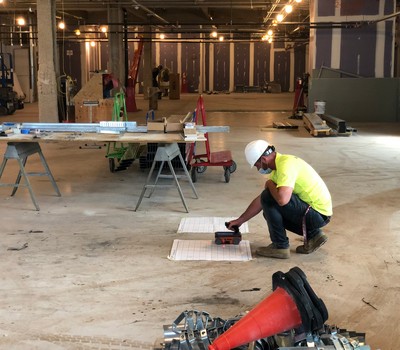Concrete Scanning: A Crucial Action In The Direction Of Making Sure Architectural Integrity and Safety And Security
In the world of building and facilities upkeep, the value of concrete scanning can not be overemphasized. This precise process holds the key to unveiling potential threats hidden beneath the surface area of apparently solid structures. By using innovative innovation and methods, concrete scanning acts as a pivotal device in making certain that the honesty and security of bridges and structures are supported to the highest possible criteria. However, past its surface-level ramifications, the duty of concrete scanning expands far much deeper than meets the eye.
Importance of Concrete Scanning
Concrete scanning plays a crucial function in ensuring the architectural stability and safety and security of buildings and facilities tasks. By using advanced innovations such as ground-penetrating radar (GPR) and electro-magnetic induction, professionals can non-destructively evaluate concrete frameworks to discover possible problems, spaces, ingrained things, and reinforcement layout. This process allows very early discovery of anomalies that might endanger the security of a framework, avoiding expensive problems and guaranteeing the safety and security of occupants.
Concrete scanning is especially vital throughout the preparation and building and construction phases of a task. Prior to exploration, reducing, or coring right into concrete, scanning helps recognize the exact areas of rebar, post-tension wires, and other ingrained elements, decreasing the risk of unexpected hits that could cause structural weaknesses. Additionally, concrete scanning aids in quality assurance by verifying the thickness of concrete covers and finding any kind of discrepancies that may impact the general toughness of the structure. Eventually, purchasing concrete scanning solutions is not only a proactive procedure to minimize threats however also a fundamental step towards maintaining the long-term safety and security and stability of structures and facilities.
Technology for Concrete Examination

Benefits of Early Discovery
Prompt detection of structural issues can substantially minimize risks and make sure the durability of building jobs. By determining prospective problems early in the building and construction procedure, stakeholders can take aggressive procedures to resolve issues before they intensify into bigger and more pricey troubles. Among the crucial benefits of early detection is the avoidance of architectural failures, which can pose serious safety and security threats and bring about task hold-ups and economic losses.
Additionally, early detection enables for timely repairs and upkeep, which can assist prolong the lifespan of the framework. By attending to problems promptly, building and construction groups can stay clear of expensive repair work and even the demand for premature replacement of structural parts. This positive approach not just saves money and time but additionally improves the overall safety and security and toughness of the building project.
In addition, early discovery can boost task planning and decision-making by providing stakeholders with useful insights into the problem of the structure. Equipped with this information, task supervisors can make informed options concerning building and construction timelines, methods, and materials, bring about a lot more successful and effective task end results.
Making Certain Structural Stability
Making certain the structural stability of a building and construction project is extremely important to its safety and durability. Structural security describes the ability of a building or facilities to keep its type and feature under various loads and environmental problems. To attain this, detailed evaluation and surveillance of the framework are important. Concrete scanning plays click for source a critical duty in guaranteeing architectural security by detecting prospective problems such as spaces, delamination, or support corrosion that can endanger the honesty of the structure with time.
By using sophisticated scanning innovations like ground-penetrating radar (GPR) and electromagnetic induction, building professionals can non-invasively examine concrete structures to determine areas of concern under the surface area. This positive approach permits the very early discovery of weaknesses or defects, enabling prompt visit their website repairs or support to stop architectural failures.
Regular concrete scanning throughout different construction stages and throughout the life cycle of a structure can aid preserve its stability, minimize threats, and make sure the safety of residents. By focusing on structural stability through concrete scanning, building and construction tasks can improve their strength and durability, inevitably adding to greater security and longevity.
Stopping Vital Failures
To secure against disastrous events, careful tracking and proactive upkeep are necessary in averting important failures within architectural frameworks. Identifying potential problems prior to they intensify is key to stopping architectural failures. Carrying out regular evaluations, such as concrete scanning, can disclose hidden problems like spaces, splits, or corrosion that might endanger the honesty of a structure. By using sophisticated scanning innovations like Ground Permeating Radar (GPR) or Concrete X-ray, engineers can non-destructively evaluate the problem of concrete and identify powerlessness that call for support or repair work - RainierGPR Service Areas.

Final Thought
Finally, concrete scanning plays a critical function in making sure structural stability and security by utilizing sophisticated innovation for early detection of potential issues. This aggressive method helps prevent vital failures and ensures the security of structures. It is vital to prioritize concrete inspection as a standard technique to shield the durability and security of buildings and framework.
Concrete scanning plays a crucial duty in making sure the structural honesty and safety and security of buildings and infrastructure tasks. Additionally, concrete scanning help in high quality control by verifying the density of concrete covers and finding any discrepancies that may affect the total toughness of the structure. Concrete scanning plays a critical function in making certain architectural stability by identifying prospective concerns such as voids, delamination, or support rust that can jeopardize the honesty of the structure over time.

In conclusion, concrete scanning plays an essential duty in ensuring structural stability and safety by utilizing advanced modern technology for very early detection of prospective problems.